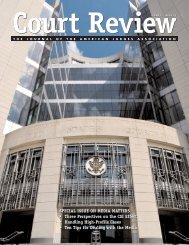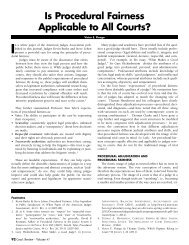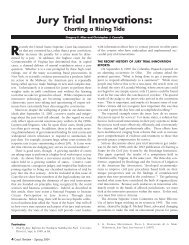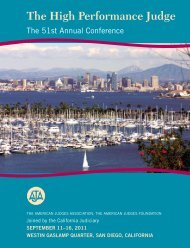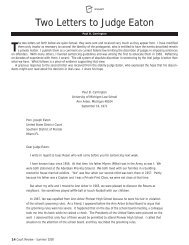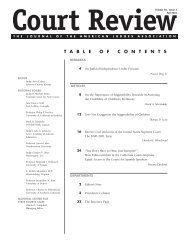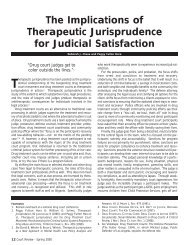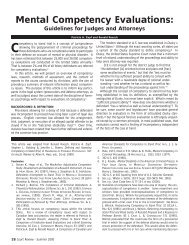Special Issue on Procedural Fairness - American Judges Association
Special Issue on Procedural Fairness - American Judges Association
Special Issue on Procedural Fairness - American Judges Association
- No tags were found...
Create successful ePaper yourself
Turn your PDF publications into a flip-book with our unique Google optimized e-Paper software.
y the authorities representing that social group, then that pers<strong>on</strong>will generally judge that procedure to be fair. Essentially,the group value model posits that people do not judge proceduresto be fair because those procedures deliver fair or favorableoutcomes, and people do not value procedural featureslike voice or respectful treatment because they signal the likelihoodof favorable outcomes. Rather, procedural features liketrust, neutrality, respect (and voice) c<strong>on</strong>vey important symbolicor relati<strong>on</strong>al informati<strong>on</strong> – they c<strong>on</strong>vey that the individualis respected by his or her group – prompting people tojudge those procedures as fair. 6 An extensive body of researchprovides str<strong>on</strong>g support for these central claims of the groupvalue model.Notably, the ascendancy of the group value model in theprocedural fairness literature is the culminati<strong>on</strong> of a significantshift from the parameters that defined early c<strong>on</strong>flict research.Psychologists have progressed from early ec<strong>on</strong>omic models ofsatisfacti<strong>on</strong> that focused primarily <strong>on</strong> obtaining favorable outcomes,to distributive fairness models that focused primarily <strong>on</strong>obtaining fair outcomes, to procedural fairness models thatfocused primarily <strong>on</strong> procedures as instruments for shaping fairoutcomes, to a procedural fairness model that views proceduresas an important source of largely symbolic informati<strong>on</strong>: informati<strong>on</strong>about <strong>on</strong>e’s relati<strong>on</strong>ship with valued social groups.Each of these developments has moved psychologists furtheraway from the propositi<strong>on</strong> that outcomes are critical determinantsof procedural fairness judgments.Psychologists have also dem<strong>on</strong>strated that procedural fairnessjudgments themselves have important social and legal c<strong>on</strong>sequences.For example, Tyler c<strong>on</strong>ducted large-scale surveys ofChicago, IL, and Oakland, CA, residents. 7 Across four studies,Tyler showed that process c<strong>on</strong>cerns were more important thaninstrumental c<strong>on</strong>cerns in shaping citizens’ evaluati<strong>on</strong>s of thepolice and courts. Judgments about the fairness with which thepolice and courts exercised their authority predicted citizens’c<strong>on</strong>fidence in and support for legal authorities, their perceivedobligati<strong>on</strong> to obey the law, and their willingness to cooperatewith legal authorities and legal instituti<strong>on</strong>s in the future—findingswhich have been replicated in numerous studies since Lindand Tyler proposed their groupvalue theory. 8<strong>Procedural</strong> fairness researchhas clearly dem<strong>on</strong>strated thatdisputants attach a great deal ofimportance to the way they aretreated by the authorities whorepresent legal instituti<strong>on</strong>s. 9Disputants’ evaluati<strong>on</strong>s of thelegal system are heavily influencedby their percepti<strong>on</strong> thatthey were treated fairly inencounters with judges, police,[F]airness andsatisfacti<strong>on</strong>judgments [ofdecisi<strong>on</strong> makerslike judges maynot be] dominatedby treatmentand relati<strong>on</strong>alc<strong>on</strong>cerns.and other legal authorities, and this procedural fairness effectoften trumps the effect of distributive fairness and outcomefavorability. 10 When procedural features like trust, neutrality,respectful treatment, and voice increase procedural fairnessjudgments, this functi<strong>on</strong>s as a n<strong>on</strong>-coercive means to increasecompliance with the law and cooperati<strong>on</strong> with legal authorities.NEW FINDINGS IN PROCEDURAL FAIRNESS: DECISIONMAKERS VS. DECISION RECIPIENTSSeveral studies have suggested the dominant influence ofprocedural fairness <strong>on</strong> satisfacti<strong>on</strong> may not apply equally to allactors in the legal system. Some studies suggest that, am<strong>on</strong>gdecisi<strong>on</strong> makers (e.g., judges), fairness and satisfacti<strong>on</strong> judgmentsare shaped by quite different factors and are not dominatedby treatment and relati<strong>on</strong>al c<strong>on</strong>cerns. For example,Lissak and Sheppard found that managers tended to emphasizecost and efficiency more str<strong>on</strong>gly than fairness as criteria forresolving organizati<strong>on</strong>al c<strong>on</strong>flict. 11 Some early procedural fairnessresearch also suggested that when assessing their satisfacti<strong>on</strong>with dispute resoluti<strong>on</strong> procedures or outcomes, decisi<strong>on</strong>makers were more influenced by instrumental criteria (such asc<strong>on</strong>trol over decisi<strong>on</strong>s and financial c<strong>on</strong>siderati<strong>on</strong>s), and lessc<strong>on</strong>cerned with relati<strong>on</strong>al criteria (such as treatment and trustworthiness),than were decisi<strong>on</strong> recipients 12 .One recent paper focused directly <strong>on</strong> judgments of proceduralfairness by judges. 13 Heuer and his colleagues point to6. E. A. LIND & TOM R. TYLER, THE SOCIAL PSYCHOLOGY OFPROCEDURAL JUSTICE (1988).7. Tom R. Tyler, Public Trust and C<strong>on</strong>fidence in Legal Authorities: WhatDo Majority and Minority Group Members Want From the Law andLegal Instituti<strong>on</strong>s?, 19 BEHAV. SCI. & L. 215 (2001).8. TOM R. TYLER ET AL., SOCIAL JUSTICE IN A DIVERSE SOCIETY (1997);Jas<strong>on</strong> Sunshine & Tom R. Tyler, Moral Solidarity, Identificati<strong>on</strong>with the Community, and the Importance of <strong>Procedural</strong> Justice: ThePolice as Prototypical Representatives of a Group’s Moral Values, 66SOC. PSYCHOL. Q. 153 (2003); Tom R. Tyler et al., Cultural Valuesand Authority Relati<strong>on</strong>s: The Psychology of C<strong>on</strong>flict Resoluti<strong>on</strong>Across Cultures, 6 PSYCHOL. PUB. POL’Y & L. 1138 (2000).9. NAT’L CTR. FOR STATE COURTS, HOW THE PUBLIC VIEWS THE STATECOURTS: A 1999 NATIONAL SURVEY (1999), available athttp://www.ncsc<strong>on</strong>line.org/WC/Publicati<strong>on</strong>s/Res_AmtPTC_PublicViewCrtsPub.pdf; DAVID B. ROTTMAN, TRUST AND CONFIDENCE INTHE CALIFORNIA COURTS: A SURVEY OF THE PUBLIC AND ATTORNEYS,PART I: FINDINGS AND RECOMMENDATIONS (JUDICIAL COUNCIL OFCALIFORNIA/ADMINISTRATIVE OFFICE OF THE COURTS 2005), availableat http://www.courtinfo.ca.gov/reference/documents/4_37pubtrust1.pdf;TOM R. TYLER, WHY PEOPLE OBEY THE LAW (2006).10. But see Linda J. Skitka, Do the Means Always Justify the Ends, Or Dothe Ends Sometimes Justify the Means? A Value Model of JusticeReas<strong>on</strong>ing, 28 PERSONALITY & SOC. PSYCHOL. BULL. 588 (2002).11. Robin I. Lissak & Blair H. Sheppard, Bey<strong>on</strong>d <strong>Fairness</strong>: TheCriteri<strong>on</strong> Problem in Research <strong>on</strong> Dispute Interventi<strong>on</strong>, 13 J. APPLIEDSOC. PSYCHOL. 45 (1983).12. E.g., R. H. G. Field & R. J. House, A Test of the Vroom-Yett<strong>on</strong> ModelUsing Manager and Subordinate Reports, 75 J. APPLIED PSYCHOL. 362(1990); Madeline E. Heilman et al., Reacti<strong>on</strong>s to Prescribed LeaderBehavior as a Functi<strong>on</strong> of Role Perspective: The Case of the Vroom-Yett<strong>on</strong> Model, 69 Journal of Applied Psychology 50 (1984); PaulineHoulden et al., Preference for Modes of Dispute Resoluti<strong>on</strong> as aFuncti<strong>on</strong> of Process and Decisi<strong>on</strong> C<strong>on</strong>trol, 14 J. EXP. SOC. PSYCHOL.13 (1978).13. Larry Heuer et al., The Role of Societal Benefits and <strong>Fairness</strong>C<strong>on</strong>cerns am<strong>on</strong>g Decisi<strong>on</strong> Makers and Decisi<strong>on</strong> Recipients, 31 LAW& HUM. BEHAV. 573 (2007).Court Review - Volume 44 63



